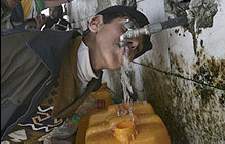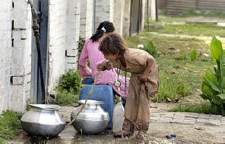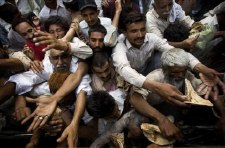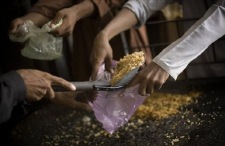At ATP, we have been writing about many critical issues facing Pakistan and Owais recently wrote on rising food prices. However, I feel that there is a serious lack of awareness about the two silent tsunamis of Water Shortage and Food Shortage which are just around the corner and we need to write a lot more about them.




Specially, the water shortage issue has not been given attention it needs. If appropriate steps are not taken we could see a water shortage situation even worse than the current power crisis as soon as 2012-13. Both issues, closely inter-linked with each other, are perhaps the greatest threats facing human beings today and absolutely critical for the survival of Pakistan.
Unfortunately, the new government so far has not been doing much about it. After abruptly abandoning Kala Bagh Dam project recently and despite tall claims, no concrete plans have yet been made public that how the water shortage issue will be tackled. PPP led coalition seems to be too busy in unnecessarily prolonging judicial crisis, protecting NROs and complaining about the aftermath of Musharraf’s 9 years who btw, still has no plans to show mercy on people of Pakistan despite clear message on 18th February. There have been alarming reports by World Bank, State Bank and the UN Food Programme, warning Pakistan about the upcoming severe water shortage and food crisis. Some experts believe that Pakistan could face Somalia and Ethiopia like famine situation if drastic measures are not taken.
Water Shortage
Only a few decades ago, Pakistan was considered to have an abundance of quality water, but a recent World Bank report stated that Pakistan was among the 17 countries that were currently facing a water shortage. In most big cities of Pakistan today, people can’t get water supply at homes without using electric motors/pumps. In a city like Lahore, on average, we get water supply 3-4 hours per day and that too with the help of electric motor.
During last 10 years or so, while we have been concentrating on Peace Process, taking U-turns on Kashmir with no results, promoting people to people contacts and releasing Kashmir Singhs, everyone else around us, realizing the water crisis have been building dams. India has silently built 62 small and medium size dams on rivers which are supposed to be Pakistan’s as per Indus Water Treaty.
Similarly, China alone is building 95 major dams with a height of 200 feet or more, Turkey is constructing 51 large dams flowed by Iran with 48, Japan with 40 and India with 10 large dams. The Sindh Tas Water Council has recently warned that the country may face acute shortage of food and that the famine situation may crop up owing to the decreasing water resources. According to Sindh Tas Water Council Pakistan Chief Organizer M Yousuf Sarwar, the biggest issue between Pakistan and India after the Kashmir is river water and India is expediting the construction work of dams an barrages on the remaining rivers of Pakistan.
The past government of Pakistan did nothing in this regard to forbid India from doing this. Yousuf Sarwar said at least 405 canals and 124 distributaries of Pakistan would dry up in the wake of Baglihar Dam construction and large swathes ranging millions of hectares of land will turn arid. He cautioned that Terbela and Mangla are at the dead level for the past two decades, adding 38 million acres of land are being spoiled without having enough water. Yousuf Sarwar pleaded the new government to prevent India from constructing new dams and take resort to the world court in this connection.
According to official government reports the per capita availability of water has gradually dwindled from 5,260-cubic metres in 1951 to 1,100-cubic metres in the current years, and is estimated to reach 550-cubic metres in 2025. However, this is also because of the fact that population of Pakistan was 33.80 million in 1951 which has now increased to 170 million. If we go by the current population increase ratio, by 2025, Pakistan will require almost double the currently available water. It must also be noted that currently, only 55% of Pakistan’s total population has access to clean drinking water.
According to the World Bank, Pakistan is currently close to using up all its surface and ground water. At present, Pakistan only stores 30 days of its river water, India stores 120 days, Egypt stores 400 days, while the Colorado River in the US stores 900 days of river water. The new reservoirs will not only push Pakistan’s economy aggressively forward and according to World Bank statistics, every new dam built by the country will add four to five percent to Pakistan’s GDP. New reservoirs are also considered vital to save the industrial sector from the consequences of a water shortage. There are over half a million small and big industrial units in the country and the estimated usage of water by all industries is 3.5 million acre feet at present but this demand is also going to continue increasing in line with ambitious production targets. Yet simultaneous measures to ensure the contamination of existing water supplies by these industries are still not being given the attention they need.
Almost same is the case with energy generation. Pakistan’s electricity demand is increasing by approximately seven percent annually, due to which the need for new water reservoirs is considered urgent. It has been calculated that Pakistan has 50,000 MW of hydro-power potential, but it is merely harnessing 14 percent against its total current requirement of 20,000 MW. Most developed countries produce 70-80% of their power from water projects and our neighbors India and China about 30% which costs around 1 rupee per unit. We on the other hand, are relying more on expansive thermal power generation which is almost 8-9 times costly and also causes major environmental pollution. By building new dams, we can even further bring the per unit price down and also fulfill the needs of agriculture sector. Although, government is claiming that it is also possible to bring down thermal energy cost by making use of one of the largest coal resources in Thar but still experts are convinced that water is the most viable and cheapest way to produce electricity. And besides, given the state of the environment, it is no longer feasible for even developing countries to merely brush aside the sustainability costs of energy production. The coal resources can be utilized in the industrial sectors or even a replacement for oil. The situation is such that one doesn’t have to a rocket scientist to understand that the only way to control energy crisis and provide people with quality drinking water is to increase the water storage capacity.
Food Shortage
Food shortage is another silent tsunami and becoming a global phenomena these days. World Bank reports suggest that we are among the 36 countries where there is serious threat of food crisis. According to the World Food Programme, the number of those suffering from food crisis in Pakistan has increased from 60 million to 77 million. This is almost half of the total population of the country.
I remember as kid we used to get a lot of free stuff like tomatoes, hari mirch and dhaniya whenever we bought vegetables but not anymore. While India and China have been controlling their exports (like putting complete ban on rice export), the policy makers in Pakistan have taken outstanding decisions like last year when they first exported so called excessive wheat and then imported it back on double price. Same is expected with rise and maize.
According to the president of the World Bank Robert Zoelick the increasing prices of food items would further make things worse for the 100 million people across the world. As per his estimates within the next three years another 100 million people across the world will join the ranks of the poor due to possible doubling of food prices. He has stressed effective steps to counter the coming new international crisis. He has also stressed that the rich countries should also provide funds for the production of food crops. Under the present circumstances 40 countries are facing crisis like situation due to increase in the prices of food items. This crisis has also resulted in creating social problems.
Majority of population in a poor country like Pakistan spends 70 per cent of their income on food items. But the present situation, particularly the increasing oil prices, has badly affected their income and expenditure balance. As on one hand there is a rapid increase in the price of food items and on the other their income has stayed limited.
I had the chance to read the State Bank of Pakistan’s quarterly report published in May 2008 and it has alarming details of the danger of having a lower overall produce of important crops in the year 2008 as compared to the last fiscal year has increased. There is a danger that this year wheat production can also remain very low. Due to the reduced produce of important crops the annual growth rate would also remain less than the target. It is projected that Pakistan will have a wheat deficit of 12 million tons per annum by 2012-13 - or in other words 31% of the projected target. Imagine the seriousness of situation in human terms as if these stats are true, we will have a large number of really hungry people in Pakistan.
Experts are suggesting that oil import bill is increasing but none of the governments has ever paid attention to the mass-transit system or seriously improving public transport system which can really help us in current situation. Due to mismanagement and increase in the international prices of oil and food items countries like Pakistan are facing multiple problems. It is absolutely vital that the government took immediate measures to curb the rising inflation and address the problems of the poor people of the country.
Few weeks ago, the minister for Water and Power Raja Pervez Ashraf announced steps to control energy crisis and load-shedding which unfortunately have not been implemented at all, probably because of absence of governance in Pakistan these days. Whether another claim of the same minister about ending energy crisis by August 2009 becomes a reality or not still remains to be seen. I think without wasting anymore time, we must give more attention to water conservation and preventing water loss within the existing irrigation system, besides trying to increase water supplies. Emergency awareness campaigns should be initiated to encourage people to use water carefully and implement save electricity plans before it is too late.
Projects like the Mangla Dam Raising, Mirani Dam, Gomal Zam Dam, Subakzai Dam and Satpara Dam are simply not enough to meet the rising demands. New mega water storage reservoirs needs to be built and steps must be taken to stop India from building dams on rivers that belong to Pakistan as per Indus-Water Treaty of 1960. It is not surprising that UN keep on warning that during next 25 years, major conflicts between countries like India and Pakistan could be on water resources. As very rightly put in an editorial of a local newspaper, “Either we put pettifogging and pernicious rivalries and narrow political advancements on hold and start building dams and their associated hydro-electric works, or Pakistan is within sight of beginning to starve to death”.
References:
1. World Bank reports on Water and Irrigation system of Pakistan
2. State Bank of Pakistan Quarterly Report, May 2008
3. Weekly Pulse, Islamabad
4. Pakistan Defence


0 comments:
Post a Comment